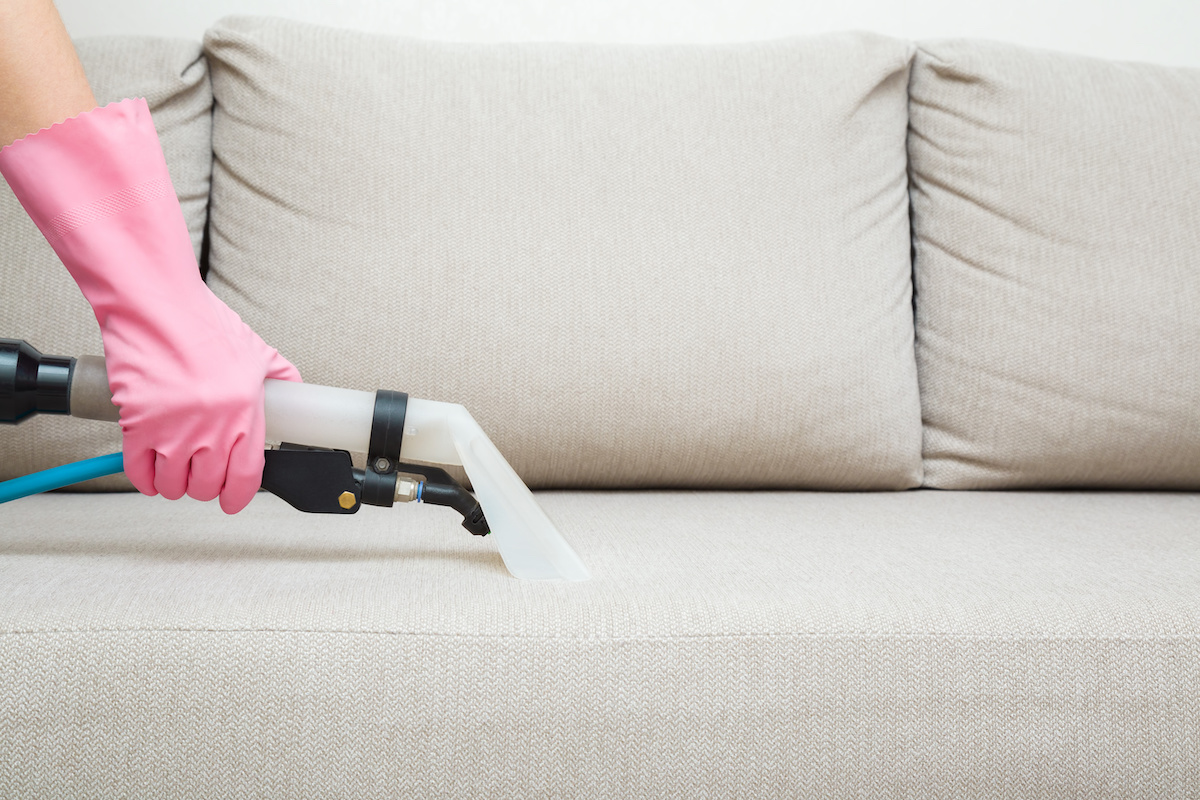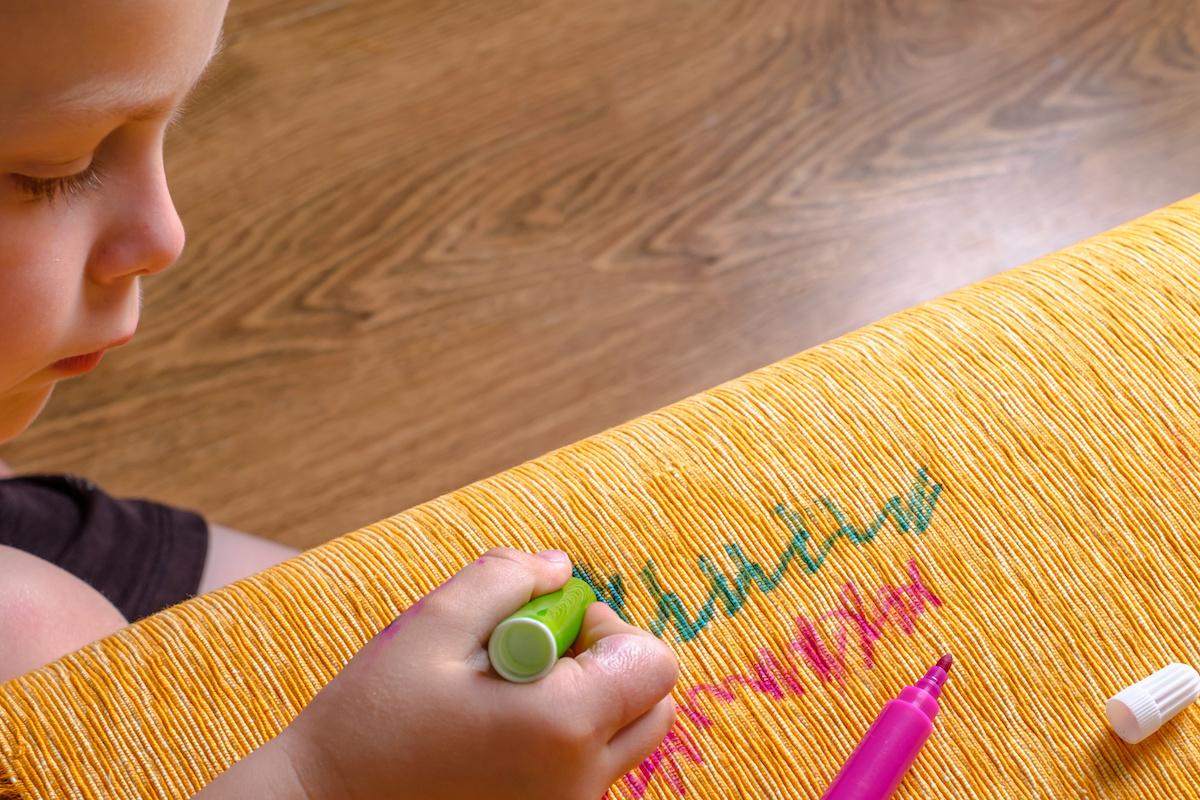
Keeping your home’s upholstery clean and fresh is not just about maintaining appearances; it’s also about prolonging the life of your furniture and ensuring a healthy environment for your family. At Professional Carpet Systems, we understand the challenges and intricacies of upholstery stain removal.
While we’re always here to lend our expertise, there are numerous DIY tips and tricks you can employ for effective stain removal. Here’s how to tackle those stubborn spots, and when it’s wise to call in the pros.
Understanding Upholstery Fabric Types
Your upholstery’s fabric type is the starting point for any cleaning endeavor. Upholstery fabrics fall into two broad categories: natural and synthetic. Natural fibers include cotton, linen, wool, and silk, while synthetic fibers encompass polyester, nylon, and acrylic.
The upholstery cleaning method suitable for your furniture depends largely on its material, making it crucial to identify this before proceeding.
Pre-Cleaning Steps for Upholstery Stain Removal
Successful upholstery cleaning begins long before any cleaning solution is applied. The following pre-cleaning steps are crucial in preparing for stain removal, ensuring not only effectiveness but also preventing damage to your furniture.
Inspection and Identification
- Fabric Type: Identifying the material of your upholstery is paramount. Different fabrics require different cleaning methods and solutions. Check the manufacturer’s tag for symbols that indicate whether water-based or solvent-based cleaners are appropriate. If you’re unsure, consulting a professional can save you from costly mistakes.
- Stain Type: Understanding the nature of the stain (oil-based, protein-based, etc.) helps in selecting the right cleaning approach. For example, grease stains require a different treatment than coffee spills.
Vacuuming
- Surface Dirt Removal: A thorough vacuuming removes dust, pet hair, and other debris. This step prevents dirt from turning into mud when a cleaning solution is applied. Use an upholstery attachment to avoid damaging the fabric.
- Debris Clearing: Pay special attention to crevices and seams where dirt accumulates. Clearing away debris ensures a more even and effective cleaning across the entire piece of furniture.
Spot Testing
- Hidden Area Testing: Always test your chosen cleaning solution on a small, inconspicuous area of the upholstery. Wait for the test spot to dry completely to assess any potential changes in color or texture.
- Safety Check: This step is crucial for ensuring the chosen method won’t cause damage. If the fabric reacts poorly, it’s time to consider a different solution or reach out to a professional.
Choosing Appropriate Tools
- Soft Brushes and White Cloths: Use soft-bristled brushes to gently work on stains without harming the fabric fibers. White cloths are preferred for blotting since they won’t transfer color to the upholstery.
- Proper Vacuum Attachments: Utilize the brush attachment on your vacuum cleaner to lift surface dirt without pulling on the fabric. This gentle approach is key to maintaining the integrity of your upholstery.
Setting Up the Area
- Work in a Well-Ventilated Space: Ensure good airflow to facilitate drying and prevent the buildup of any fumes from cleaning solutions, especially when using solvents.
- Protect Surrounding Areas: Use drop cloths or plastic sheeting to protect surrounding floors and furniture from any overspray or spills during the cleaning process.
These pre-cleaning steps are designed to set you up for success in your DIY upholstery cleaning endeavors. By taking the time to properly inspect, prepare, and test before tackling stains, you ensure not only the effectiveness of your efforts but also the long-term beauty and durability of your furniture.

DIY Upholstery Stain Removal Tips
- Immediate Action
- Speed is of the essence when dealing with spills. The quicker you act, the less likely the stain will set, making it easier to remove.
- Blotting vs. Rubbing
- Always blot spills gently with a clean, white cloth. Rubbing can push the stain deeper into the fabric and cause the spill to spread.
- Choosing the Right Cleaner
- Deciding between homemade solutions and commercial cleaners depends on the stain type and fabric. For many common stains, a mixture of clear dish soap and water can be effective. However, more challenging stains may require specific formulas or commercial options.
- Application Techniques
- Apply your chosen cleaner sparingly, using a soft-bristled brush or cloth to gently work on the stain. Avoid saturating the fabric, as excessive moisture can lead to mildew.
Specific Stain Removal Guides
- Food and Drink Stains
- For food and drink spills, a mixture of vinegar and water can often lift the stain. Apply the mixture, blot, and repeat until the stain fades.
- Oil and Grease Stains
- Cornstarch or baking soda can be effective at absorbing oil and grease. Sprinkle on the stain, let sit for a few hours, then vacuum.
- Ink and Marker Stains
- Rubbing alcohol dabbed onto a cloth can be used to blot away ink stains. Pat gently until the ink transfers to the cloth.
- Pet Stains and Odors
- For biological stains, an enzymatic cleaner specifically designed for pet stains is your best bet, as it breaks down the stain and neutralizes odors.
Professional Upholstery Cleaning
If the stain persists despite your best efforts, or if you’re dealing with delicate fabrics, it’s time to call in the professionals. Professional Carpet Systems has the tools, techniques, and solutions to effectively remove stubborn stains without damaging your furniture.
We provide comprehensive upholstery cleaning services that extend beyond stain removal to rejuvenate and protect your furniture. With advanced cleaning solutions and techniques, we ensure your upholstery is meticulously cleaned, leaving it looking and smelling fresh.

Maintenance Tips for Upholstery Care
Upholstery, when well-maintained, can withstand the test of time and everyday use, maintaining its color, texture, and comfort. Here are detailed strategies for keeping your upholstered furniture in top condition:
Routine Cleaning
- Vacuum Regularly: Use the upholstery attachment on your vacuum cleaner to gently remove dust and dirt from the fabric surface at least once a week. This prevents the accumulation of grime that can embed into and wear down fibers over time.
- Brush Softly: For textiles that don’t fare well with vacuuming, use a soft-bristled brush to gently sweep away dust without damaging delicate fibers.
Immediate Stain Prevention and Treatment
- Act Quickly on Spills: The sooner you address spills, the less likely they are to set into stains. Blot spills gently with a clean, dry cloth; avoid rubbing, which can work the liquid deeper into the fibers.
- Use Appropriate Cleaners: Knowing the type of fabric and the nature of the stain is key to choosing the right cleaner. Always spot test in an inconspicuous area first.
Avoid Sunlight and Pollutants
- Protect from Sunlight: Direct and even indirect sunlight can fade and weaken upholstery fabric over time. Position furniture away from direct sunlight and use curtains or blinds to filter light.
- Minimize Contact with Pollutants: Smoke, cooking fumes, and even certain indoor air fresheners can leave residues or cause fading. Ensure good ventilation and consider air purifiers in high-traffic areas.
Professional Deep Cleaning
- Schedule Regular Professional Cleanings: Even with diligent care, professional deep cleaning is recommended every 12 to 24 months to remove embedded dirt and oils that household cleaning cannot reach. This can rejuvenate your furniture’s appearance and prolong its life.
Fabric Protection
- Consider Fabric Protectors: After a professional cleaning, applying a fabric protector can help repel stains and spills, making future cleanings easier. Ensure the product is suitable for your upholstery type.
Rotate Cushions
- Regular Rotation: Flipping and rotating cushions regularly can promote even wear and extend the life of the seats. This helps maintain shape and comfort, preventing premature sagging and indentations.
Avoid Sharp Objects and Pet Damage
- Protect from Damage: Keep sharp objects, like scissors or pens, away from your upholstery to avoid accidental punctures or scratches. Provide scratching posts and toys to deter pets from using furniture as their playground.
Educate and Implement
- Educate Household Members: Ensure all family members, including children, understand the basics of upholstery care. Simple rules, like not eating on the sofa, can prevent many potential stains.
- Use Throws and Slipcovers: Decorative throws or slipcovers not only enhance the aesthetic appeal but also serve as a protective barrier against wear and tear. They can be easily removed and cleaned, offering an additional layer of protection.
By following these maintenance tips, you can enjoy your upholstered furniture for many years, keeping it looking fresh and vibrant.
Remember, while regular DIY care is important, the expertise of professionals like those at Professional Carpet Systems can play a pivotal role in addressing deeper cleaning needs, restoring your upholstery to its original beauty, and ensuring its longevity.
Need Upholstery Stain Removal?
Tackling upholstery stains can be a straightforward task with the right knowledge and tools. Remember, the key to effective stain removal is prompt action and the correct cleaning method.
For those stubborn, set-in stains, or when dealing with delicate fabrics, Professional Carpet Systems is here to help. Our expertise ensures your upholstery remains a clean, comfortable, and beautiful part of your home.